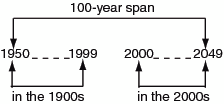YEARCUTOFF= System Option
Specifies the first year of a 100-year span that
is used by date informats and functions to read a two-digit year.
| Valid in: | Configuration file, SAS invocation, OPTIONS statement, SAS System Options window |
| Category: | Input control: Data processing |
| PROC OPTIONS GROUP= | INPUTCONTROL |
| Note: | This option can be restricted by a site administrator. For more information, see Restricted Options. |
Details
The YEARCUTOFF= value
is the default that is used by various date and datetime informats
and functions.
If the default value
of nnnn (1920) is in effect,
the 100-year span begins with 1920 and ends with 2019. Therefore,
any informat or function that uses a two-digit year value that ranges
from 20 to 99 assumes a prefix of 19. For example, the value 92 refers
to the year 1992.
The value that you specify
in YEARCUTOFF= can result in a range of years that span two centuries.
For example, if you specify YEARCUTOFF=1950, any two-digit value between
50 and 99 inclusive refers to the first half of the 100-year span,
which is in the 1900s. Any two-digit value between 00 and 49, inclusive,
refers to the second half of the 100-year span, which is in the 2000s.
The following figure illustrates the relationship between the 100-year
span and the two centuries if YEARCUTOFF=1950.
See Also
The Year 2000 in SAS Language Reference: Concepts
